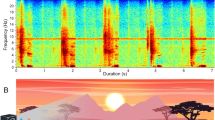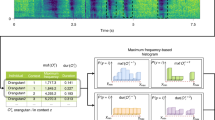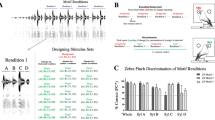Abstract
Personal names are a universal feature of human language, yet few analogues exist in other species. While dolphins and parrots address conspecifics by imitating the calls of the addressee, human names are not imitations of the sounds typically made by the named individual. Labelling objects or individuals without relying on imitation of the sounds made by the referent radically expands the expressive power of language. Thus, if non-imitative name analogues were found in other species, this could have important implications for our understanding of language evolution. Here we present evidence that wild African elephants address one another with individually specific calls, probably without relying on imitation of the receiver. We used machine learning to demonstrate that the receiver of a call could be predicted from the call’s acoustic structure, regardless of how similar the call was to the receiver’s vocalizations. Moreover, elephants differentially responded to playbacks of calls originally addressed to them relative to calls addressed to a different individual. Our findings offer evidence for individual addressing of conspecifics in elephants. They further suggest that, unlike other non-human animals, elephants probably do not rely on imitation of the receiver’s calls to address one another.
This is a preview of subscription content, access via your institution
Access options
Access Nature and 54 other Nature Portfolio journals
Get Nature+, our best-value online-access subscription
$32.99 / 30 days
cancel any time
Subscribe to this journal
Receive 12 digital issues and online access to articles
$119.00 per year
only $9.92 per issue
Buy this article
- Purchase on SpringerLink
- Instant access to full article PDF
Prices may be subject to local taxes which are calculated during checkout




Similar content being viewed by others
Data availability
Data are available at https://doi.org/10.5061/dryad.hmgqnk9nj (ref. 60).
Code availability
Code is available at https://doi.org/10.5281/zenodo.10576772 (ref. 61).
Change history
17 July 2025
A Correction to this paper has been published: https://doi.org/10.1038/s41559-025-02823-3
References
Fitch, W. T. The evolution of language: a comparative review. Biol. Philos. 20, 193–230 (2005).
Macedonia, J. M. & Evans, C. S. Variation among mammalian alarm call systems and the problem of meaning in animal signals. Ethology 93, 177–197 (1993).
Clay, Z., Smith, C. L. & Blumstein, D. T. Food-associated vocalizations in mammals and birds: what do these calls really mean? Anim. Behav. 83, 323–330 (2012).
Wheeler, B. C. & Fischer, J. Functionally referential signals: a promising paradigm whose time has passed. Evol. Anthropol. 21, 195–205 (2012).
Smith, E. A. Communication and collective action: language and the evolution of human cooperation. Evol. Hum. Behav. 31, 231–245 (2010).
Dingemanse, M., Blasi, D. E., Lupyan, G., Christiansen, M. H. & Monaghan, P. Arbitrariness, iconicity, and systematicity in language. Trends Cogn. Sci. 19, 603–615 (2015).
King, S. L. & Janik, V. M. Bottlenose dolphins can use learned vocal labels to address each other. Proc. Natl Acad. Sci. USA 110, 13216–13221 (2013).
Balsby, T. J. S., Momberg, J. V. & Dabelsteen, T. Vocal imitation in parrots allows addressing of specific individuals in a dynamic communication network. PLoS ONE 7, e49747 (2012).
Janik, V. M. & Sayigh, L. S. Communication in bottlenose dolphins: 50 years of signature whistle research. J. Comp. Physiol. A 199, 479–489 (2013).
Poole, J. H., Tyack, P. L., Stoeger-Horwath, A. S. & Watwood, S. Elephants are capable of vocal learning. Nature 434, 455–456 (2005).
Stoeger, A. S. et al. An Asian elephant imitates human speech. Curr. Biol. 22, 2144–2148 (2012).
Soltis, J., Leong, K. & Savage, A. African elephant vocal communication II: rumble variation reflects the individual identity and emotional state of callers. Anim. Behav. 70, 589–599 (2005).
Clemins, P. J., Johnson, M. T., Leong, K. M. & Savage, A. Automatic classification and speaker identification of African elephant (Loxodonta africana) vocalizations. J. Acoust. Soc. Am. 117, 956–963 (2005).
McComb, K., Moss, C., Sayialel, S. & Baker, L. Unusually extensive networks of vocal recognition in African elephants. Anim. Behav. 59, 1103–1109 (2000).
Poole, J. H. in The Amboseli Elephants: A Long-Term Perspective on a Long-Lived Mammal (eds Moss, C. J. et al.) 125–159 (Univ. Chicago Press, 2011).
Breiman, L. Random forests. Mach. Learn. 45, 5–32 (2001).
Rhodes, J. S., Cutler, A. & Moon, K. R. Geometry- and accuracy-preserving random forest proximities. IEEE Trans. Pattern Anal. Mach. Intell. 45, 10947–10959 (2023).
Foley, N. M. et al. A genomic timescale for placental mammal evolution. Science 380, eabl8189 (2023).
Dahlin, C. R., Young, A. M., Cordier, B., Mundry, R. & Wright, T. F. A test of multiple hypotheses for the function of call sharing in female budgerigars, Melopsittacus undulatus. Behav. Ecol. Sociobiol. 68, 145–161 (2014).
Wanker, R., Sugama, Y. & Prinage, S. Vocal labelling of family members in spectacled parrotlets, Forpus conspicillatus. Anim. Behav. 70, 111–118 (2005).
Prat, Y., Taub, M. & Yovel, Y. Everyday bat vocalizations contain information about emitter, addressee, context, and behavior. Sci. Rep. 6, 39419 (2016).
Wittemyer, G., Douglas-Hamilton, I. & Getz, W. M. The socioecology of elephants: analysis of the processes creating multitiered social structures. Anim. Behav. 69, 1357–1371 (2005).
Archie, E. A., Moss, C. J. & Alberts, S. C. The ties that bind: genetic relatedness predicts the fission and fusion of social groups in wild African elephants. Proc. R. Soc. B 273, 513–522 (2006).
Howard, D. J., Gengler, C. & Jain, A. What’s in a name? A complimentary means of persuasion. J. Consum. Res. 22, 200–211 (1995).
King, S. L., Sayigh, L. S., Wells, R. S., Fellner, W. & Janik, V. M. Vocal copying of individually distinctive signature whistles in bottlenose dolphins. Proc. R. Soc. B 280, 20130053 (2013).
Baotic, A. & Stoeger, A. S. Sexual dimorphism in African elephant social rumbles. PLoS ONE 12, e0177411 (2017).
Stoeger, A. S., Zeppelzauer, M. & Baotic, A. Age-group estimation in free-ranging African elephants based on acoustic cues of low-frequency rumbles. Bioacoustics 23, 231–246 (2014).
Zaman, S. R., Sadekeen, D., Alfaz, M. A. & Shahriyar, R. One source to detect them all: gender, age, and emotion detection from voice. In Proc. IEEE 45th Annual Computers, Software, and Applications Conference 338–343 (IEEE, 2021).
Berg, K. S., Delgado, S., Cortopassi, K. A., Beissinger, S. R. & Bradbury, J. W. Vertical transmission of learned signatures in a wild parrot. Proc. R. Soc. B 279, 585–591 (2012).
Stevens, S. S., Volkmann, J. & Newman, E. B. A scale for the measurement of the psychological magnitude pitch. J. Acoust. Soc. Am. 8, 185–190 (1937).
Vernes, S. C. et al. The multi-dimensional nature of vocal learning. Philos. Trans. R. Soc. B 376, 20200236 (2021).
Bradbury, J. W. & Balsby, T. J. S. The functions of vocal learning in parrots. Behav. Ecol. Sociobiol. 70, 293–312 (2016).
Connor, R. C. Dolphin social intelligence: complex alliance relationships in bottlenose dolphins and a consideration of selective environments for extreme brain size evolution in mammals. Philos. Trans. R. Soc. Lond. B 362, 587–602 (2007).
Bachorec, E. et al. Spatial networks differ when food supply changes: foraging strategy of Egyptian fruit bats. PLoS ONE 15, e0229110 (2020).
Kerth, G., Perony, N. & Schweitzer, F. Bats are able to maintain long-term social relationships despite the high fission–fusion dynamics of their groups. Proc. R. Soc. B 278, 2761–2767 (2011).
Moss, C. J. & Poole, J. H. in Primate Social Relationships: An Integrated Approach (ed. Hinde, R. A.) 315–325 (Blackwell Science, 1983).
Altmann, J. Observational study of behavior: sampling methods. Behaviour 49, 227–267 (1974).
de Silva, S. Acoustic communication in the Asian elephant, Elephas maximus maximus. Behaviour 147, 825–852 (2010).
R Core Team. R: a language and environment for statistical computing. R Foundation for Statistical Computing https://www.R-project.org (2022).
Sueur, J., Aubin, T. & Simonis, C. seewave, a free modular tool for sound analysis. Bioacoustics 18, 213–226 (2008).
Ligges, U., Krey, S., Mersmann, O. & Schnackenberg, S. tuneR: analysis of music and speech. R Project https://CRAN.R-projet.org/package=tuneR (2018).
Anikin, A. Soundgen: an open-source tool for synthesizing nonverbal vocalizations. Behav. Res. Methods 51, 778–792 (2019).
Heffner, R. S. & Heffner, H. E. Hearing in the elephant (Elephas maximus): absolute sensitivity, frequency discrimination, and sound localization. J. Comp. Physiol. Psychol. 96, 926–944 (1982).
Ren, Y. et al. A framework for bioacoustic vocalization analysis using hidden Markov models. Algorithms 2, 1410–1428 (2009).
Davis, S. B. & Mermelstein, P. Comparison of parametric representations for monosyllabic word recognition. IEEE Trans. Acoust. 28, 357–366 (1980).
Sykulsi, M. rpca: RobustPCA: decompose a matrix into low-rank and sparse components. R package version 0.2.3. R Project https://CRAN.R-project.org/package=rpca (2015).
Thomson, D. J. Spectrum estimation and harmonic analysis. Proc. IEEE 70, 1055–1096 (1982).
Correll, J., Mellinger, C. & Pedersen, E. J. Flexible approaches for estimating partial eta squared in mixed-effects models with crossed random factors. Behav. Res. Methods 54, 1626–1642 (2022).
Wright, M. N. & Ziegler, A. ranger: a fast implementation of random forests for high dimensional data in C++ and R. J. Stat. Softw. 77, 1–17 (2017).
Wittemyer, G. & Getz, W. M. Hierarchical dominance structure and social organization in African elephants, Loxodonta africana. Anim. Behav. 73, 671–681 (2007).
Archie, E. A., Morrison, T. A., Foley, C. A. H., Moss, C. J. & Alberts, S. C. Dominance rank relationships among wild female African elephants, Loxodonta africana. Anim. Behav. 71, 117–127 (2006).
Archie, E. A., Moss, C. J. & Alberts, S. C. in The Amboseli Elephants: A Long-Term Perspective on a Long-Lived Mammal (eds Moss, C. J. et al.) 238–245 (Univ. Chicago Press, 2011).
Blanca, M. J., Alarcón, R., Arnau, J., Bono, R. & Bendayan, R. Non-normal data: is ANOVA still a valid option? Psicothema 29, 552–557 (2017).
Strobl, C., Boulesteix, A. L., Kneib, T., Augustin, T. & Zeileis, A. Conditional variable importance for random forests. BMC Bioinform. 9, 307 (2008).
Poole, J. H., Payne, K., Langbauer, W. R. J. & Moss, C. J. The social contexts of some very low-frequency calls of African elephants. Behav. Ecol. Sociobiol. 22, 385–392 (1988).
Poole, J. H. & Granli, P. in The Amboseli Elephants: A Long-Term Perspective on a Long-Lived Mammal (eds Moss, C. J. et al.) 109–124 (Univ. Chicago Press, 2011).
Therneau, T. M. coxme: mixed effects cox models. R package version 2.2-18.1. R Project https://CRAN.R-project.org/package=coxme (2019).
Bates, D., Mächler, M., Bolker, B. M. & Walker, S. C. Fitting linear mixed-effects models using lme4. J. Stat. Softw. 67, 1–48 (2015).
Kleiber, C. & Zeileis, A. Applied Econometrics with R (Springer, 2008).
Pardo, M. African elephants address one another with individually specific calls. Dryad https://doi.org/10.5061/dryad.hmgqnk9nj (2024).
Pardo, M. African elephants address one another with individually specific calls. Zenodo https://doi.org/10.5281/zenodo.10576772 (2024).
Acknowledgements
We thank the Office of the President of Kenya, the Samburu, Isiolo and Kajiado County governments, the Wildlife Research & Training Institute of Kenya, and Kenya Wildlife Service for permission to conduct fieldwork in Kenya. We thank Save The Elephants and the Amboseli Trust for Elephants for logistical support in the field, J. M. Leshudukule, D. M. Letitiya and N. Njiraini for assistance with the fieldwork, G. Pardo for blinding the playback stimuli and S. Pardo for input on the statistical analyses. We thank J. Berger, W. Koenig and A. Horn for comments on the manuscript. This project was funded by a Postdoctoral Research Fellowship in Biology to M.A.P. from the National Science Foundation (award no. 1907122) and grants to J.H.P. and P.G. from the National Geographic Society, Care for the Wild, and the Crystal Springs Foundation. Fieldwork was supported by Save the Elephants.
Author information
Authors and Affiliations
Contributions
M.A.P. conceived the study. M.A.P. and D.S.L. collected the data in Samburu, and J.H.P. and P.G. collected the data in Amboseli. M.A.P. and K.F. performed the statistical analysis, and M.A.P. created the figures. M.A.P. drafted the manuscript, and K.F., J.H.P. and G.W. edited it. C.M., I.D.-H. and G.W. provided resources and access to long-term datasets, and G.W. supervised the study.
Corresponding author
Ethics declarations
Competing interests
The authors declare no competing interests.
Peer review
Peer review information
Nature Ecology & Evolution thanks Kenna Lehmann and the other, anonymous, reviewer(s) for their contribution to the peer review of this work. Peer reviewer reports are available.
Additional information
Publisher’s note Springer Nature remains neutral with regard to jurisdictional claims in published maps and institutional affiliations.
Extended data
Extended Data Fig. 1 Schematic illustrating how spectral acoustic features were measured.
First, a spectrogram was calculated by applying a Fast Fourier Transform to the signal (Hamming window, 700 samples, 90% overlap). Then a mel filter bank with 26 overlapping triangular filters between 0-500 Hz was applied to each window of the spectrogram to produce a mel spectrogram. The mel spectrogram was then normalized by dividing the energy value in each cell by the total energy in that time window and these proportional energies were logit-transformed so they would not be limited to between 0 and 1. As features for the robust principal components analysis, we used the vector of energy in each of the 26 mel frequency bands as well as the vectors of delta and delta-delta values for each frequency band (representing the change and acceleration in energy over time, respectively). In the spectrogram and mel spectrogram in this figure, warmer colors indicate higher amplitudes (greater energy).
Extended Data Fig. 2 Scatterplots illustrating the separation in 3D space between calls from the same caller to different receivers.
Axes are the first three principal coordinates extracted from the proximity scores of a random forest trained to predict receiver ID. Each plot represents a single caller, each point is a single call, and receiver IDs are coded by both color and shape. This figure only includes calls where caller ID was known for certain, where the call was predicted correctly in at least 25% of random forest iterations, and where the caller made at least two such calls each to at least two different receivers.
Extended Data Fig. 3 Scatterplot illustrating the clustering in 3D space of calls from different callers to the same receiver.
Axes are the first three principal coordinates extracted from the proximity scores of a random forest trained to predict receiver ID. Each shape represents a different receiver and each color represents a different caller. This figure only includes calls where caller ID was known for certain, where the call was predicted correctly in at least 25% of random forest iterations, and where the receiver received at least one such call each from at least two different callers.
Supplementary information
Rights and permissions
Springer Nature or its licensor (e.g. a society or other partner) holds exclusive rights to this article under a publishing agreement with the author(s) or other rightsholder(s); author self-archiving of the accepted manuscript version of this article is solely governed by the terms of such publishing agreement and applicable law.
About this article
Cite this article
Pardo, M.A., Fristrup, K., Lolchuragi, D.S. et al. African elephants address one another with individually specific name-like calls. Nat Ecol Evol 8, 1353–1364 (2024). https://doi.org/10.1038/s41559-024-02420-w
Received:
Accepted:
Published:
Issue date:
DOI: https://doi.org/10.1038/s41559-024-02420-w
This article is cited by
-
Looking back on 2024
Nature Ecology & Evolution (2025)
-
AI is helping to decode animals’ speech. Will it also let us talk with them?
Nature (2025)
-
Ethical implications of AI-mediated interspecies communication
AI and Ethics (2025)
-
Evolution of body size and selfhood: Size-scaling from selfless reproduction to enhanced self-preservation
Journal of Biosciences (2025)
-
Learned use of an innate sound-meaning association in birds
Nature Ecology & Evolution (2025)



